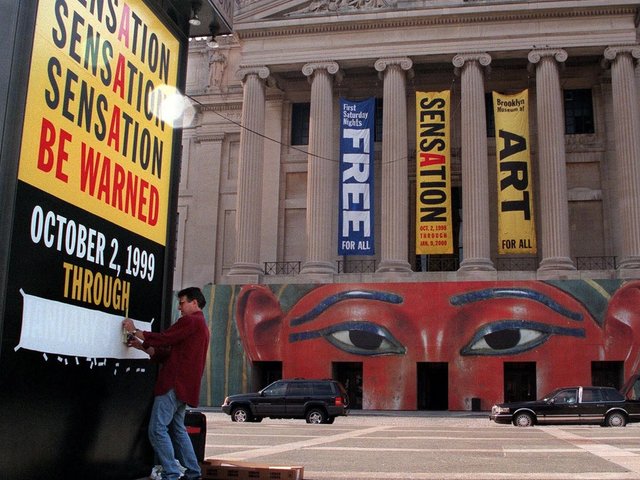When the storm broke over The Satanic Verses, Salman Rushdie did a U-turn on British culture. He had been one of the most energetic scourges of this sceptic isle, but once he was victim of a fatwah, he became an outspoken defender of the freedoms that are available in British cultural life. So too, in less tragic circumstances, artists and intellectuals who instinctively loathed the Arts Council rallied round when Thatcher put the boot in. In both instances it was a case of better the devil you know...
In New York, incursions on the National Endowment for the Arts have lead to some equally startling volte-faces. Suddenly, the ineffable goodness of the NEA and public funding is being proclaimed by many whose professional lives have been spent very-nicely-thank-you in NEA-free zones in the private sector.
Joseph Kosuth’s 1990 installation at the Brooklyn Museum, “The Play of the Unmentionable”, was one such apologia. The high priest of Conceptual Art took a cross-section of works from the museum’s collection and chicly installed them next to a range of wall-texts. Thus Hiram Powers’s “Greek Slave”, Jacobite wineglasses, Oriental erotica and Bauhaus furniture co-habited with quotes from historical figures such as Hitler and Rousseau and from contemporary luminaries such as Leo Steinberg and Stephen Greenblatt. The show was seen by over 90,000 people.
The lavish catalogue that has now been produced includes an explanatory essay by David Freedberg, an art historian whose book The Power of Images was cited in the show. According to Freedberg, the aim of Kosuth’s installation was to “engender self-reflexiveness in each viewer’s judgment about the relations between art, morality and censorship”. For him, “the whole of art became the questioning of art”. A truly political art, he realised, would not content itself with the message alone; it would—it had to—engage the viewer in a questioning of the nature of the institutions and the pressures they exert, and thereby subject them to the necessary critique.
Hamlet re-visited, or Art aspiring to the condition of group therapy for the chattering classes? Nowhere does anything get subjected to the “necessary critique”, because neither Freedberg nor Kosuth can bring themselves to make their minds up on anything. Their post-modern capaciousness and their pluralistic desire to see every side of an argument renders it unconstitutional to say boo to a goose. Instead of lean convictions and supple value judgments, they treat us to a slick orgy of channel-hopping (Hiltler word-bite plus Mapplethorpe sight-bite and so on) and feed us quivering slices of deconstruction, done to a turn. Punctuating their banquet of the senses are intellectually tipsy toasts to “freedom of expression”. Wisdom has never been so truly infinite...
With one exception. The only real whipping-boy is party-pooper Hans Haacke, the tireless toiler whose word/image exposés have shown the way that dirty money gets laundered through the art world. Freedberg: “For Kosuth, then, an art such as Hans Haacke’s—in which the message lies primarily in the content—simply reinforces the positions already held by his viewers. It is too unambiguous. It cannot change anyone because it fails to question its status as art and, therefore, its institutional presumptions and presuppositions”.
This is a most pathetic piece of pontification, even if we appreciate that modern artists are some of the greatest censors of art (i.e. Rauschenberg erasing de Kooning). Haacke has provoked resignations at the Guggenheim, and storms at the Tate over Charles Saatchi. Yes, he is more interested in exposing hypocrisy than in making arty art, but there’s a need for that too. There is a time for ambiguity and there is a time for action. One wonders what Haacke would make of Kosuth: “after years wrapped up in Wittgenstein and promoted by Castelli, mothballed Master of the Ascetic-Esoteric jumps on PC bandwaggon and fills museum with bums and blow-jobs...”
The narcissistic and windy urbanity of Freedburg and Kosuth means that they fail to convince us that there is something rotten in the United States. Where hedging of bets (“ambiguity”) is not just feasible but desirable, we can only assume that the problem is not cancer, but hypochondria.
Kosuth’s show was not called the play of the unmentionable for nothing: for Establishment Man, the whole censorship scam must seem like a glorified game-show that can be viewed with Olympian detachment, fingers poised on the remote-control button.
And for many in New York, it is a game show: in the Nineties the censorship debate is keeping contemporary art in the media spotlight, just as obscene auction prices did in the Eighties. The artworld exploits and thrives on both. They are duly grateful to Joseph Kosuth for keeping the ball rolling while not rocking the boat.
Essay by David Freedberg with introduction by Charlotta Kotik “The Play of the Unmentionable”, an installation by Joseph Kosuth at the Brooklyn Museum (Thames and Hudson, London, 1992) 148pp. 21 col. ills., 105 duotone, £24
Originally appeared in The Art Newspaper as “He keeps the ball rolling while not rocking the boat”


